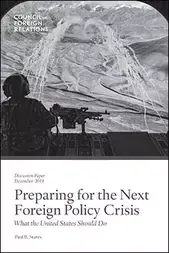Contingency Planning for Future Crises
Project Expert

General John W. Vessey Senior Fellow for Conflict Prevention and Director of the Center for Preventive Action
About the Project
The United States has a poor record at both anticipating foreign crises and planning for them. To improve U.S. readiness for crises that are both plausible in the short- to medium-term and likely to be harmful to U.S. interests, the Center for Preventive Action routinely convenes Contingency Planning Roundtables to discuss practical prevention and mitigation strategies. These discussions form the basis for CPA’s well-regarded Contingency Planning Memoranda series. CPA also organizes “Flashpoint” Roundtables to draw wider attention to current or prospective sources of conflict.
The “Flashpoint” Roundtable series is made possible by the generous support of the Carnegie Corporation of New York.
-
Terrorism and Counterterrorism
Violence around U.S. elections in 2024 could not only destabilize American democracy but also embolden autocrats across the world. Jacob Ware recommends that political leaders take steps to shore up civic trust and remove the opportunity for violence ahead of the 2024 election season. -
Vladimir Putin’s grip on power in Russia does not appear as ironclad as it once did. Liana Fix and Maria Snegovaya recommend that the United States prepare for potential leadership change in Moscow and develop response strategies with its allies to mitigate fallout.
-
With al-Qaeda and the self-proclaimed Islamic State in Khorasan growing in strength since the U.S. withdrawal, Seth Jones lays out a strategy for the United States to prevent a renewed terrorist threat from emerging in Afghanistan.
-
To prevent Russia's ongoing invasion of Ukraine from escalating into a wider European conflict, Thomas Graham recommends that the United States bolster its deterrence efforts with NATO partners, while leaving the door open for Russia to de-escalate.
-
China-India tensions remain high. To reduce the threat of conflict, Daniel S. Markey recommends the U.S. boost aid to India and begin working with like-minded partners to develop a coordinated response strategy.
-
The Center for Preventive Action has compiled an accessible overview of the Afghan peace negotiations, including the U.S.-Taliban agreement, the U.S.-Afghan government joint declaration, and the ongoing intra-Afghan process.
-
The United States has reached an agreement with the Taliban, but significant challenges, such as political power-sharing, the role of Islam, and women’s rights, remain for achieving intra-Afghan peace.
-
A renewed crisis on the Korean Peninsula could arise in the next twelve months. The United States should revamp UN sanctions and revitalize multilateral diplomacy in opposition to North Korea's nuclear development.
-
The trade war, fallout from COVID-19, and increased military activity raise the risk of conflict between the United States and China in the South China Sea. Oriana Skylar Mastro offers nine recommendations for ways the United States can prevent or mitigate a military clash.
-
-
The Venezuelan crisis threatens the interests and security of the United States and Venezuela's neighbors. The United States and regional partners need to provide humanitarian relief and security assistance and accelerate change to a post-Maduro democracy.
-
Recognizing that a bungled leadership transition and continuing economic stagnation in Algeria would have significant ramifications for U.S. counterterrorism interests and regional stability, the United States should take steps—including precautionary measures—to manage the risk.
-
Domestic politics in China, political trends in Taiwan, and changing U.S. policy toward Taiwan are increasing the risk of a cross-strait crisis in the coming months. The United States should take steps to help avoid and, if necessary, mitigate a confrontation.
-
In addition to a sharp economic downturn, Venezuela faces a humanitarian crisis. The United States can do little to prevent a downward spiral, but it should take measures to mitigate the political, economic, and humanitarian consequences of a potential mass emigration.
-
Tensions are rising in the Balkans and the risk of renewed violence is growing, but the United States can help preserve peace and stability in the region.
-
Neither Israel nor Hezbollah may want to return to war, but the risk of conflict is real—especially in Syria. The Trump administration can take action to prevent unintended escalation.
-
-
-
-
-
-
-
-
-
-
-
-
-
-
-
-
-
-
-
-
-
-
-
-
-
-
-
-
-
-
-
-
-
-
-
-
-
-
 Online Store
Online Store
